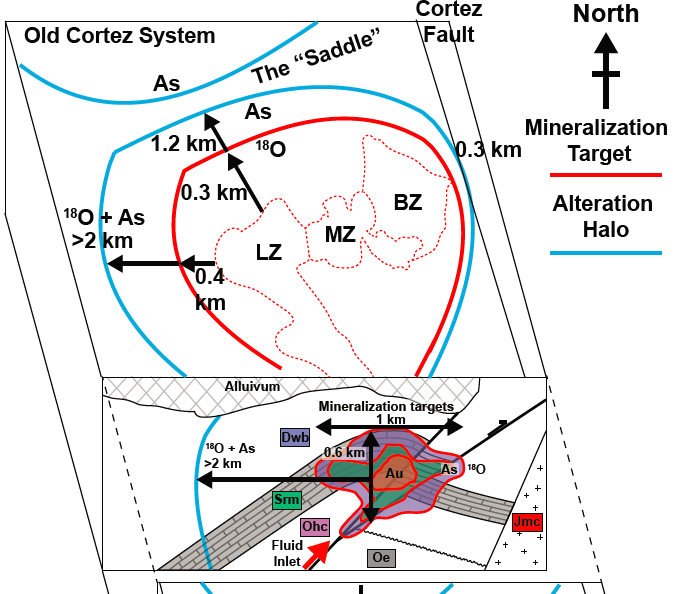Research at MDRU has documented spatial variations of several geochemical and isotopic features that characterize the giant Cortez Hills gold system in Nevada. These results contributed to defining the significant hydrothermal footprints of the giant Carlin systems and providing a basis for more effective exploration decision-making. The research constitutes the MSc thesis completed by Christopher Herron, supervised by Prof. Greg Dipple and sponsored by Barrick Gold Corporation.

Mapping the Carbonate Alteration Footprint of the Cortez Hills Carlin-type Gold Deposit, Nevada using Carbon-Oxygen Isotopes, and Geochemistry as a Vectoring Tool
Abstract
The Cortez Hills deposit is located along the Battle-Mountain Eureka Trend in north-central Nevada and is a world-class Carlin-type (CTD) gold deposit. Visible and cryptic alteration associated with mineralization were used to define footprints, alteration halos, mineralization targets and fluid pathways.
Approximately 2,500 carbon and oxygen isotope analyses from a mm- to m-scale using core, chips, pulped rock and surface samples together with geology and geochemistry provided an integrated dataset for evaluating fluid transport and alteration in the Cortez Hills plumbing system. The Cortez Hills plumbing system was described using calcite veins. Timing of calcite veins were based on cross-cutting relationships relative to alteration and mineralization events. Three main vein stages were identified which includes ten vein types and two stylolite events. Cross-cutting relationships were supported by vein physical characteristics to improve identification. Calcite veins at Cortez Hills have distinct physical and chemical characteristics that can be identified with a variety of methods. Chemical characteristics were used to understand the processes that formed veins. V2 veins associated with Carlin fluids could be a significant fluid pathway contributing to the hydrothermal plumbing system. Calcite veins have the potential to be used as an exploration tool for Carlin systems.
Invisible alteration was described using carbon and oxygen stable isotopes, and Carlin pathfinder elements (As, Au, Hg, Sb, and Tl) as a vectoring tool. Oxygen isotopes represented the most far-field detectable feature of CTDs and were used to define the cryptic carbonate alteration of Cortez Hills. Defining thresholds for carbon and oxygen isotopes, and pathfinder elements were integral to map alteration halos (lower threshold), define mineralization targets (upper threshold) and map fluid flow pathways. Isotopes and pathfinder elements were described in order of greatest distance traveled outboard of economic gold ore zones and utilized as a vectoring tool for alteration and mineralization: 18O>As>Hg>Sb>Tl-13C>Au. The defined 18O deposit footprint (lower threshold) was >3.5 km and the pathfinder element alteration halo was 2.2 km in size. The defined 18O mineralization target (upper threshold) was 1km in width and 0.6 km in height.
Click here to access full thesis from UBC Library.



